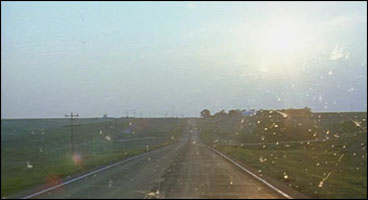
As it turned out, however, The Brown Bunny reminded me very strongly of another notorious effort by a do-it-all auteur: Manos, the Hands of Fate. Manos begins with endless shots of boring countryside while light music plays; there are several similar sequences in The Brown Bunny. Both films have an uncanny knack for placing the camera in exactly the wrong place; I can't recall the last time a film focused so obsessively on the back of the protagonist's head. Gallo's performance is even vaguely reminiscent of John Reynolds's turn as Torgo. The plot of The Brown Bunny, such as it is, involves Gallo's character miraculously getting into intimate situations with random women he encounters — at one point he begs a gas station clerk to drop everything and come with him to California, and she does; at another point he passes Cheryl Tiegs at a rest stop and then doubles back and starts making out with her. I can almost accept this, though, at least as a metaphor; I remember back in '99 finding myself suddenly on smooching terms with someone I'd known for less than three months and whom I had only met in person a few hours earlier, and so Gallo's kisses with the gas station girl had a certain familiarity to them. In every case, however, he abruptly bails, and it turns out that, like a character in an Egoyan film, he's reenacting the defining moment of his life to date, which is sort of trite. Maybe this movie would be better with wisecracking robots.
Reader Andrew Miller writes in to point out about Best in Show:
This is certainly the case with the yuppie couple, and I suppose you could say that each breed of dog is chosen to reflect its sponsor. But I'm interrupting—
I don't normally reply to email publicly, but I thought this was too interesting not to post as a followup. Yes, absolutely — when you think about it, the very concept of a competitive dog show is the most ridiculous thing in the movie. If Christopher Guest had invented the idea of a contest in which judges decide which dog out of a group of different breeds is "best," it would be a stroke of comic genius. Even if he'd drawn attention to the absurdity of a contest based on nothing, it would have improved the movie. But since dog shows (complete with ESPN coverage) actually do exist, and since the movie focused on the unrelated wackiness of the different contestants (the promiscuity of the terrier owner, the ventriloquism of the southern guy, etc.), I came away feeling that dog shows were a randomly chosen milieu and that it could just as easily have been set in the world of, say, folk music or community theater.
Return to the Calendar page! |

